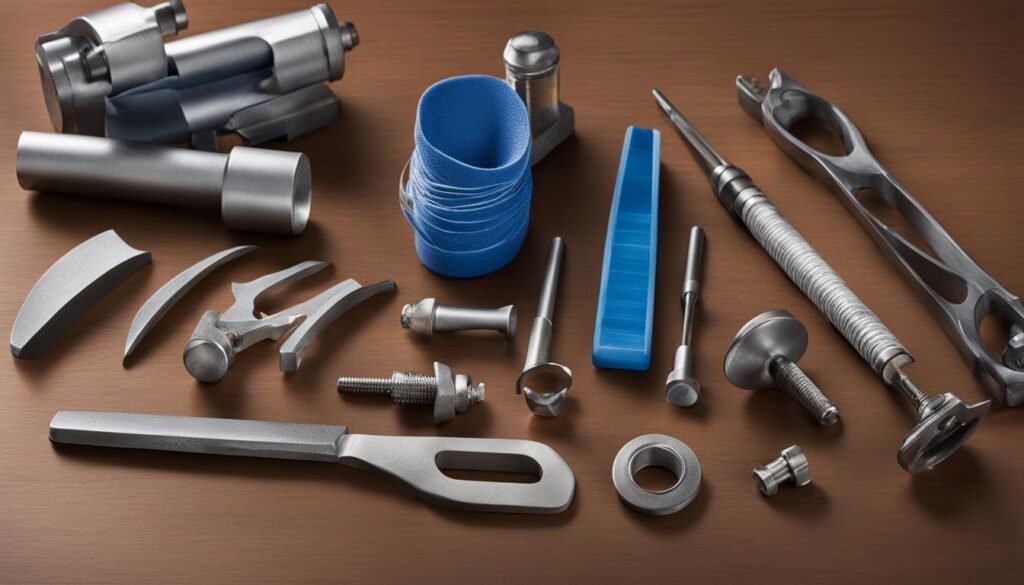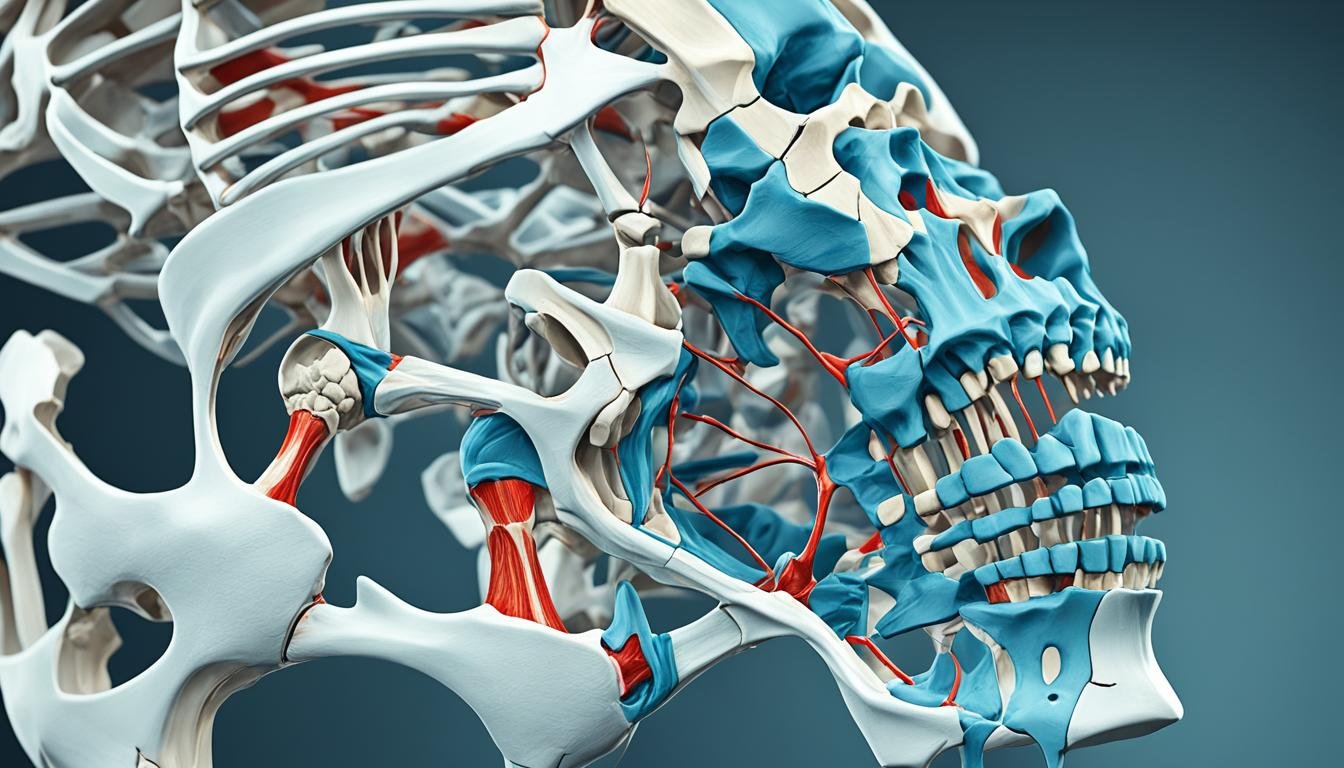Every year, the U.S. sees about 6.3 million fractures and dislocations. These injuries can hurt a lot and may stop you from moving freely. They might even cause long-term problems if not taken care of right away. Knowing the signs, symptoms, and how to treat them is vital for fast healing, whether it’s a broken bone or a joint that’s out of place.
Key Takeaways:
- Fractures and dislocations are common injuries that can cause pain, immobility, and long-term complications.
- Prompt medical attention and appropriate treatment are crucial for proper healing and recovery.
- First aid measures, such as immobilization and controlling bleeding, should be followed before seeking medical help.
- Treatment options for fractures and dislocations may include immobilization, splinting, casting, surgery, and rehabilitation.
- If you suspect a fracture or dislocation, it is important not to attempt to force the bone or joint back into place.
Understanding Fractures
A fracture is when you break a bone. It can be a small crack or a big break. The amount of force on the bone determines how bad it is. Bones can break from a hit, weakening, or too much use.
It’s very important to get medical help quickly to heal right. Treatment depends on the fracture. You might need:
- Immobilization: This uses casts, splints, or braces to keep the area still. It helps the bone heal right.
- Splinting: Sometimes, a splint is used to hold a fracture. This is until you can get more treatment.
- Casting: Casts help keep broken bones in place. They provide support and protection while healing.
- Surgery: For bad breaks, surgery might be needed. This can involve metal plates, screws, or rods to fix the bones.
Getting the right treatment and managing a fracture well is key to a good recovery. Always follow your doctor’s advice for the best healing. This helps avoid problems later on.
“Getting help quickly is key to healing right and preventing more breaks.”
Understanding Dislocations
A dislocation happens when a bone at a joint is forced out of place. This can make the joint stiff, swollen, and misshapen. Dislocations often occur in shoulders, elbows, fingers, hips, knees, and ankles. They can happen due to falls, car crashes, or sports injuries. It is critical to see a doctor quickly for treatment.
Treatment may include resting, applying ice, lifting the injured area, and sometimes surgery.

Treatment Options for Dislocations
The treatment for a dislocation depends on where and how badly you are hurt. A healthcare professional will usually try to put the bone back in place. This step is called reduction. It might be done by hand or with special techniques and tools. After putting the joint back, you may need a splint, brace, or cast to keep it still while it heals. Doing physical therapy exercises can also help you get better.
In difficult or serious cases, surgery might be needed. This is to fix any other harm, mend torn ligaments or tendons, or rebuild the joint. The goal of surgery is to make the joint stable, lower the risk of it happening again, and ensure the best recovery.
If your joint is dislocated, or you think it might be, get medical help right away. An orthopedic specialist can check you, decide how to treat you, and help you heal.
First Aid for Fractures and Dislocations
Immediate first aid is key for fractures and dislocations. It helps minimize further harm and aids in healing. By using the DRSABCD plan and good first aid, we can manage these injuries well before help arrives.
Controlling Bleeding and Immobilization
If bleeding is present, press down with a clean cloth or bandage. This helps control the bleeding. Once the bleeding stops, keep the injured area still. Use wide bandages to limit movement around the hurt area.
Using Padded Splints
A padded splint provides extra support. You can make one from newspapers, towels, or clothes. Place it gently alongside the injury, making sure it’s secure but not too tight to stop blood flow. Always check the area is getting enough blood, by looking for changes like paleness or feeling numb.
Rest, Elevation, and Ice
The RICE method is good for dislocated joints. Avoid moving it, keep it raised above your heart, and apply ice for 15-20 minutes. Don’t try to push the injury back into place yourself – this could make things worse.

Minor Dislocations
For small dislocations, like in a finger, you might be able to carefully fix it. But, it’s smarter to get medical help. This ensures everything is set right and avoids future issues.
Seeking Medical Help
First aid is a great first step, but always seek medical help for these injuries. Get medical care right away if the bone is sticking out, or if there’s a head, neck, or back injury. Medical experts offer treatments like surgery or care for dislocations. They make sure you get back on track safely.
First aid is crucial in treating fractures and dislocations. But, never let it replace professional medical help. Getting to a doctor quickly is key for the best care and recovery.
Treatment Options for Fractures and Dislocations
Treatment options for fractures and dislocations depend on the injury’s type and how bad it is. Your healthcare provider will look into your case. They will choose the best treatment plan for you.
Immobilization is usually the first step for treating fractures. This can be done with casts, splints, or braces. These tools help keep the broken bone in place and allow it to heal properly.
Sometimes, surgery might be needed to fix and stabilize broken bones. This is often the case for complex or open fractures, or if there’s damage to the tissues around the bone. The surgery might use screws, plates, or rods to hold the bones together while they heal.
Physical therapy and rehabilitation are crucial in recovering from fractures and dislocations. These treatments help gain back strength, flexibility, and movement. They also ease pain, lessen swelling, and stop future problems.
Therapy for dislocated joints aims to get back strength and movement. It could include muscle-strengthening exercises, techniques to put the joint back in place, and using heat or ice to lessen inflammation and pain.
Following your healthcare provider’s advice is key to a good recovery. Sticking to the treatment plan is vital for healing well and avoiding lasting issues.
Each fracture or dislocation is different, so treatment is customized to your situation. Trust your healthcare provider to lead you on the path to feeling better.
Consult your healthcare provider for advice and treatment options for fractures and dislocations. They will guide you to the best action plan suited to your needs.
When to Seek medical Help
Some fractures and dislocations can be cared for at home. But, you must get medical help in certain cases. Get medical help right away if:
- There is a suspected injury to the head, neck, or back.
- There is bone sticking out of the skin.
- Bleeding does not stop after applying firm pressure.
- There is loss of feeling or warmth beyond the injured area.
- The person is seriously injured.
Medical pros can give the right treatment in these situations. They might do surgery to help heal properly. Always put your health first. If in doubt, seek medical help without delay.
| Emergency Situations | Actions to Take |
|---|---|
| Suspected injury to the head, neck, or back | Seek immediate medical help |
| Bone sticking out of the skin | Do not attempt to push the bone back in. Cover the wound with a clean cloth and seek immediate medical attention |
| Bleeding does not stop after applying firm pressure | Apply additional pressure and seek immediate medical help |
| Loss of feeling or warmth beyond the injured area | Seek immediate medical attention |
| Person is seriously injured | Call emergency services or go to the nearest emergency room for immediate medical assistance |
Conclusion
Handling broken bones, fractures, and joint dislocations needs quick action and the right treatment. First aid measures are vital and getting medical help is important. For healing, immobilizing, splinting, or casting might be what’s needed. But, broken bone surgery might be necessary in tough cases.
Care for joint dislocation might include therapy to get strength and movement back. It’s key to stick to the treatment plan and do physical therapy and rehab. This helps you recover fast and stay healthy.
For the best treatment plan, talk to your healthcare provider. They’ll look at your injury’s type and how bad it is. This helps them pick the best way to treat your fracture or joint dislocation. Listening to their advice and getting medical help when needed is crucial for your recovery.
If you’re in the United States and need legal advice for your injuries, reach out to Super Attorneys Of Irvine. Call them at 949-996-9546 or go to their website at businesslawyersirvine.com. They have skilled attorneys ready to help with the legal side of broken bone surgeries, fracture treatments, and joint dislocation care.

